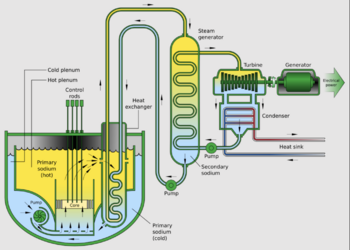Natrium reactor
The Natrium reactor is a Fast Neutron Reactor using molten sodium as the coolant.[1]
This article will address the issues raised in the parent article Nuclear power reconsidered.
Safety
Accidental overheating. The pool of molten sodium has enough heat capacity to absorb the decay heat if there is a total loss of power. Hot sodium will rise by convection and continue the flow of coolant through the core. This reactor is "walk-away safe".
Leakage of Radioactivity There are no penetrations that could leak in the vessel containing the primary sodium. Secondary sodium is non-radioactive, so a leak in that piping would not be a radiation hazard. The chamber containing sodium circuits can be flooded with argon to suppress any fires.
Sabotage The reactor vessel and all radioactive components are below ground level, under heavy concrete barriers. If a terrorist or rogue operator were to try and force a meltdown, the fuel in the rods would melt before the steel cladding, flow out of the core, and the reaction would stop. There would be no release of radioactivity outside the reactor vessel.
Waste Management
Add text here.
Weapons Proliferation
Add text here.
Cost
Specs for a 500MWe plant:
Plant cost per KW (including building but not land, permits or licensing):
Operating cost per KWh (including fuel and maintenance):
Initial fuel load:
Fuel consumption per day:
